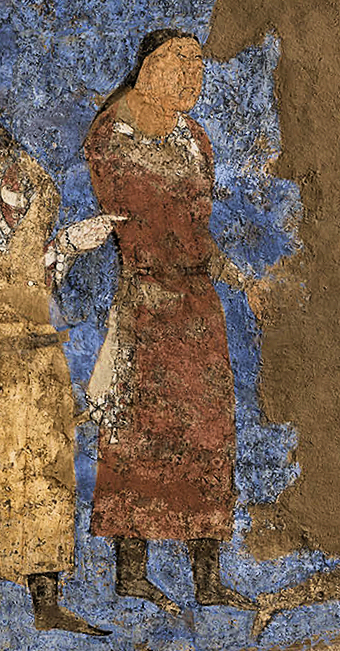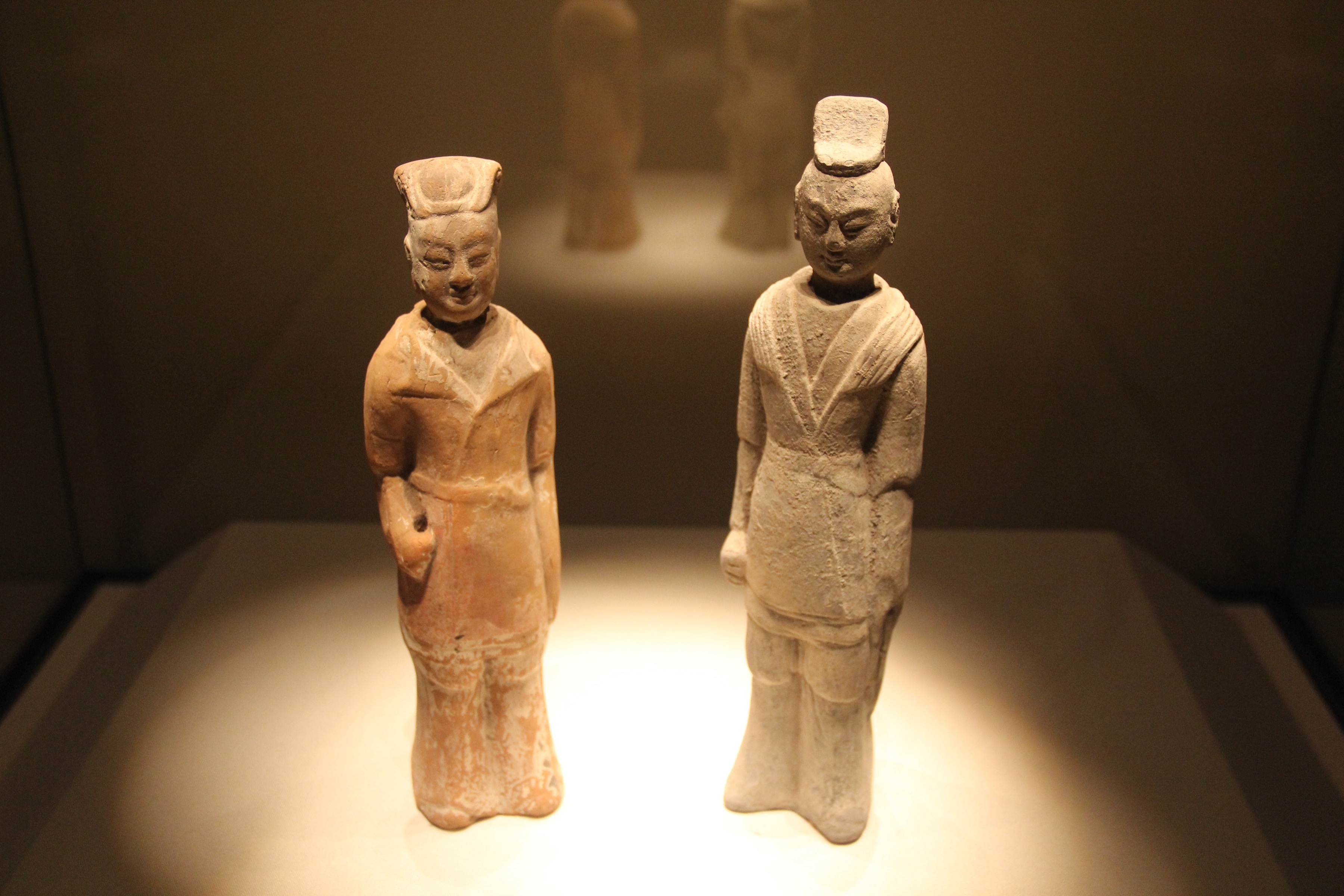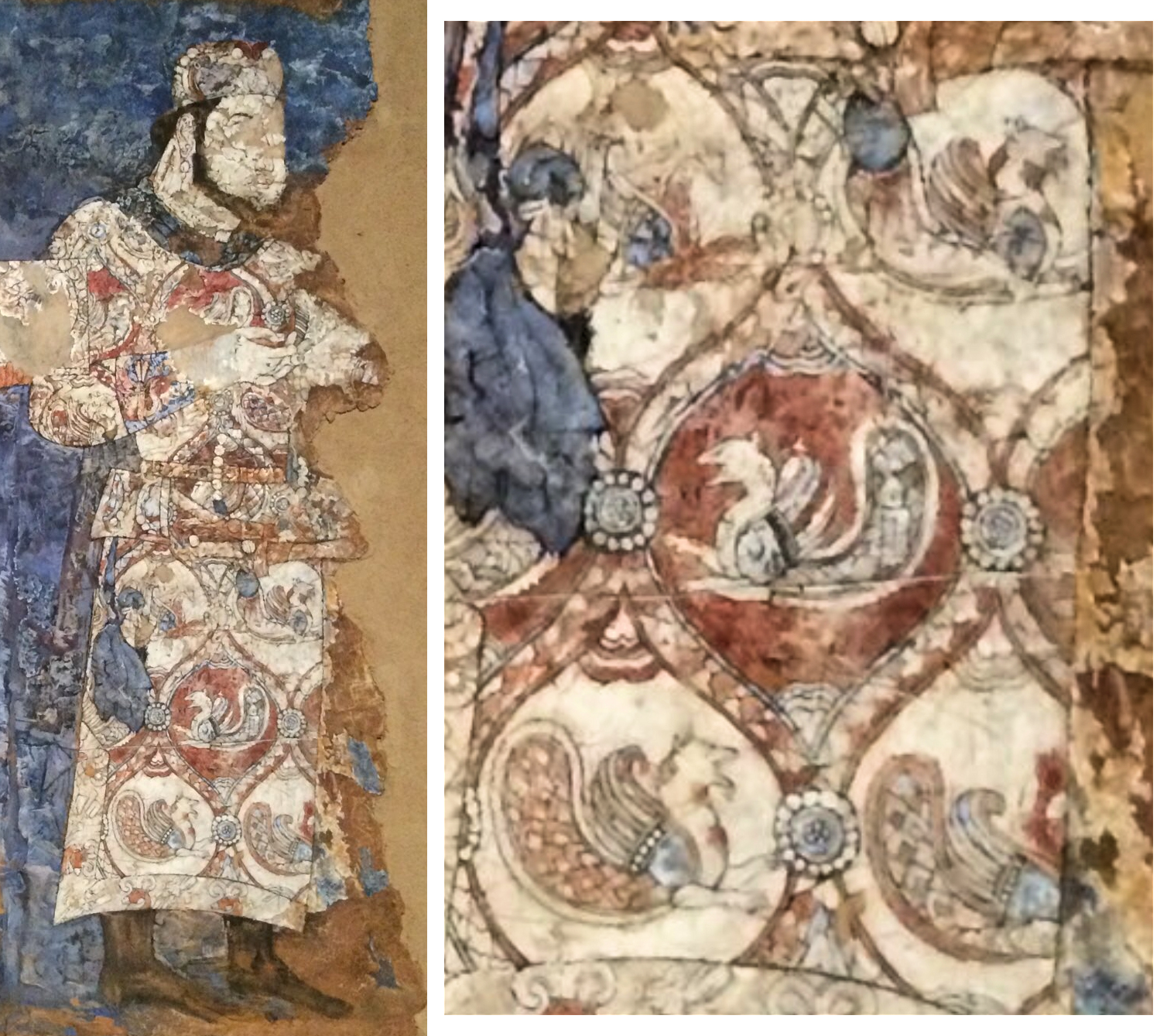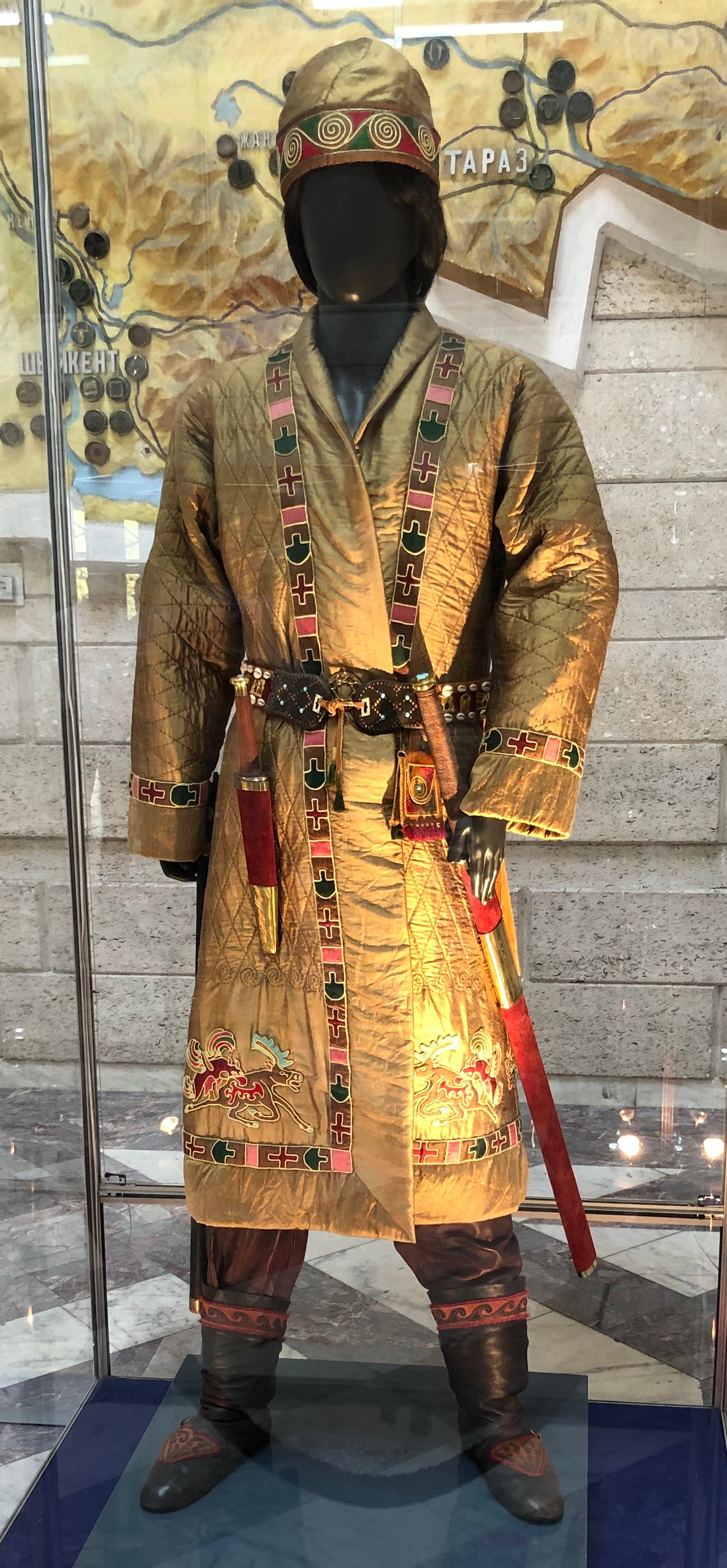Introduction
The kaftan (Persian خفتان) or qaftan (Arabic: قفطان), is a garment that has transcended cultures and epochs, epitomises a fusion of practicality, elegance, and cultural significance. Given the etymological root of the word is Persian, this article will adhere to a spelling that closely aligns with the Persian or Farsi pronunciation, namely “kaftan.”
Typically made from materials such as wool, cashmere, cotton, or silk, and often adorned with a sash, the kaftan serves as both a coat and an overdress, extending down to the ankles with long sleeves. This versatile robe has been embraced by a multitude of cultures along the Silk Roads for thousands of years, evolving into various regional styles and holding diverse social meanings. This article delves into the origins, historical trajectory, and cultural significance of the kaftan, illustrating its journey from Central Asia to its widespread adoption across Eurasia and its enduring legacy in contemporary fashion.
Origins and Early Spread
The kaftan is believed to have originated in Central Asia, potentially tracing back to Mesopotamian roots. By c. 1st millennium CE, the garment had spread across Eurasia, becoming a staple in many cultures. Its adoption in West Asia, particularly in Persia and Byzantium, marked the beginning of its broader popularity. Initially considered ‘foreign attire,’ the kaftan soon permeated Northern Caucasus and Central Europe, reaching as far as Scandinavia. The luxurious versions of the kaftan, especially those made from silk, became symbols of elite status.
In China, the introduction of hufu style garments and attire occurred during the reign of King Wuling of Zhao (c. 325-299 BCE). The term ‘Hu’ was adopted to refer to non-Han Chinese populations, including the ancient ‘Hu’ northern nomadic groups, such as the Xiongnu, as well as peoples from the Western regions, such as the Sogdians, Sasanid Persians, Turkic peoples (Tujue), Uyghurs (Huihe or Huihu), Tibetans (Tufan), and Khitans (Qidan), who resided in the northern and western regions of the empire. Thus, the hufu which often translated as ‘barbarian clothing’, ‘nomadic clothing’ or ‘foreigners’ dress,’ referred in general to any non-Han Chinese garments worn by people in and around ancient China.
During the Tang Dynasty (618–907 CE), the hufu was favoured by high-class individuals, reflecting the garment’s association with foreign luxury. It can be inferred that the extensive interactions among societies along the Silk Road, coupled with the presence of Chinese silk in kaftans unearthed at various sites along this trade route, suggest that the hufu may have been an ancient precursor to or a version of the kaftan.
Hebei, 1948. National Museum: China through the Ages, Exhibit 5. Complete indexed photo collection at WorldHistoryPics.com.; Photo Credit: Gary Todd; Xinzheng, China; https://shorturl.at/6SLo1
A woman wearing a lapel Hufu, a hat, and a fur belt (copy of stone carvings unearthed in Xi’an, Shaanxi); c. 7 Century CE; Shanxi Province China; https://shorturl.at/ZNd8k
Cross-Cultural Influences and Archaeological Evidence
The design and style of kaftans often mirrored the close interactions between societies along the Silk Roads. This cultural exchange is evident in the numerous examples of kaftans uncovered at archaeological sites. These garments, often found in burial sites, reveal the extent of cross-cultural influences in their design motifs, materials, and the contexts in which they were worn. For instance, at an Alan burial site in the North west Caucasus dating from c. 600-800 CE, 16 silk kaftans were discovered. These kaftans, believed to be payments for local customs duties, showcased a blend of Sogdian, Chinese, and Byzantine silk origins. One particularly notable kaftan features the simurgh, a mythological creature of Sassanian origin, depicted within roundel medallions—a popular design in goods traded along the Silk Roads.
Delegate with Simurgh design on his dress; Afrasiab murals, c. 648-651 CE; Samarkand, Uzbekistan; https://shorturl.at/0n5Dx
Similarly, a well-preserved red woollen kaftan from c. 3rd-4th centuries CE was found in the Tarim Basin, suggesting Central Asian craftsmanship. Another bright red and yellow woollen kaftan from c. 4th-5th centuries CE, uncovered at a burial site in Yingpan, exhibits design features and fabrics indicative of Gandhara or Khotan origins. This kaftan is decorated with human figures representing the Greek god Eros alongside horned sheep or goats beneath pomegranate trees—a design blending Sassanian and Gandharan artistic elements.
Representations in Art and Diplomatic Significance
The kaftan’s cosmopolitan nature and its role as a diplomatic gift and status symbol are evidenced by its frequent depiction in art. Murals from the 3rdcentury CE synagogue at Dura-Europos near the Euphrates River and the 7thcentury Afrasiab wall paintings in present-day Samarkand, Uzbekistan, illustrate dignitaries and ambassadors wearing kaftans. These representations highlight the garment’s significance in indicating the wearers’ elite status and cultural affiliations.
Afrasiab West Wall; Afrasiab murals, c. 7th century1 CE; Samarkand, Uzbekistan; https://shorturl.at/lMg9a
Western Turk Officer; Afrasiab murals, c. 7th century CE; Samarkand, Uzbekistan; https://shorturl.at/kbl79
From Inner Mongolia to Asia Minor, and Eastern Europe
The kaftan appears to be the oldest form of Turkish dress, with its origins traceable to the Hun and Göktürk periods. The Huns, who ruled the vast steppes of Inner Mongolia in c. second millennium BCE, are a significant tribe in Turkish history. They adapted to the harsh conditions of the Inner Mongolian Plateau and maintained their nomadic lifestyle. The Huns developed clothing suited to the steppe culture and climate, with the primary sources for examining Hun dress culture found in their cairns or memorial / burial sites. The cairns in the Noin-Ula and Ivolga areas are particularly significant. Under the leadership of P. Kazlov, these sites named after the Noin-Ula Mountains were discovered and excavated in 1924-25. Silk kaftans, woollen shawls, and fur hats (resembling janissary headgear) found in these cairns provide valuable insights into Hun dress during this period.
Reconstruction of a Xiongnu (Hun) chief warrior of c. 2nd century BCE, by archaeologist A.N. Podushkin, Central State Museum of Kazakhstan https://shorturl.at/lprmP
These clothes and belts later influenced the Göktürks (Kok-Turks) or the ‘Blue Turks’. The costume of the Göktürk period consisted of long kaftans fastened with a belt at the waist, as observed in Göktürk statues. Traces of certain patterns and sewing techniques seen in the clothes of the Turkish folks of Central Asia are evident. During the time of King Wuling (c. 325-299 BCE) of the Zhao Dynasty, precautions against the dangers posed by the Hun troops included adopting Hun military dress. This adoption of Hun-style clothing led to significant changes in palace traditions, resulting in a “clothing reform” in China.
Hun clothing appears to have been influenced by Chinese and other nomadic communities, in addition to Turkish tribes. The Hun style has left a lasting impact and traces can be seen in modern Turkish fashion. Noin-Ula kurgans and the tombs at Derestuy, Eigin-Gol, and Ivolga, where Hun clothing and accessories were discovered, are important archaeological resources. The robes, trousers, janissary headgear, and shoe soles found in the Noin-Ula cairns are valuable sources for understanding Hun dress. The cut and style of these clothes are reflected in the Göktürk period, and traces of Hun fashion are evident in Turkish clothing dating back to Central Asia and Europe.
The kaftan was the favoured garment in Turkic states of Central Asia, the Turkic Empire in India, the Seljuk Turks, and the Ottomans. It was the most important component of dress during the Seljuk period. In fact, the 10th-century travel journals of Ibn Fadlan from the Abbasid court provide evidence that the kaftan, or a similar garment, was already prevalent amongst the Turks, the Rus, the Slavs, and the Bashkirs in the regions surrounding the Middle Volga and the Caspian Sea.
Conclusion
The evolution of the kaftan illustrates its journey from its origins in Inner Mongolia to the Caspian Sea. This significant garment emerged through the assimilation of diverse cultural exchanges across a vast geography spanning two continents. In our subsequent segment, we will explore how the kaftan influenced international fashion, extending its reach across three continents under the patronage and influence of the Ottoman Empire.





